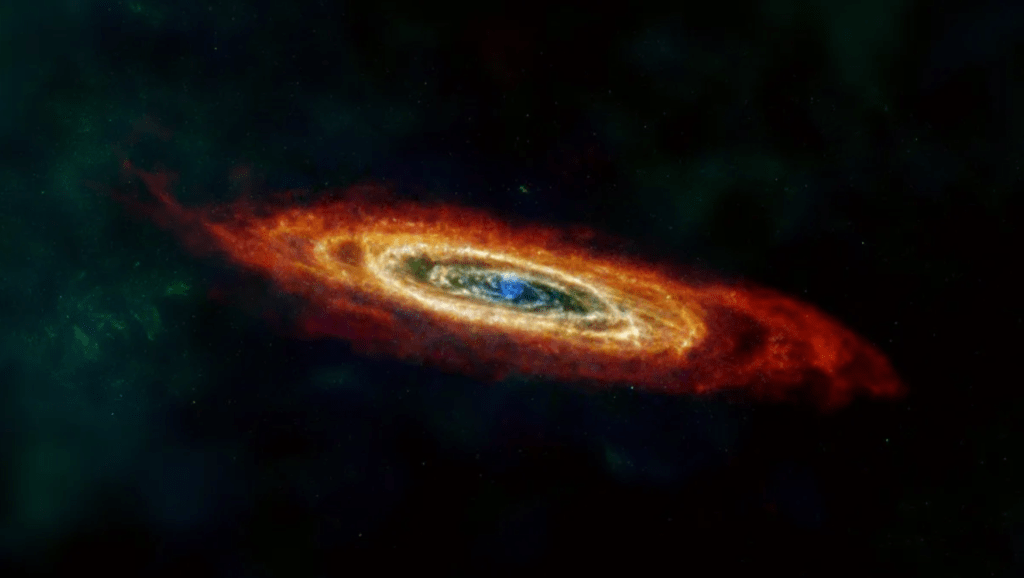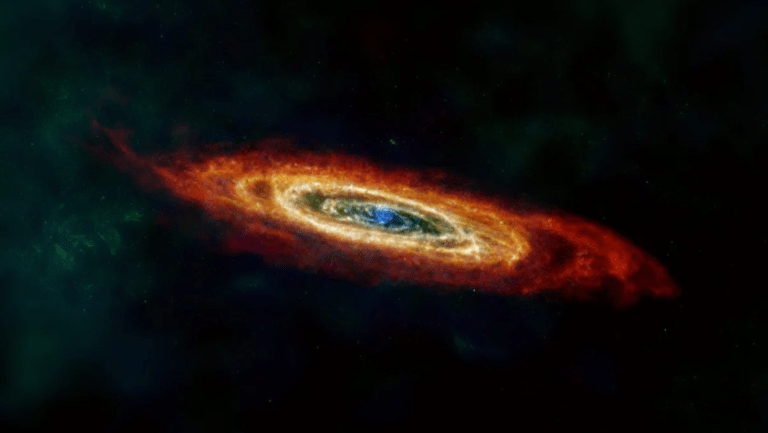Insights into Andromeda’s Turbulent Past Unearthed Through Galactic Archaeology in Our Milky Way’s Vicinity
Through chemical analysis of stars in the neighboring galaxy, we’ve discovered that its formation was marked by greater chaos than that of our own galaxy.

An international consortium of astrophysicists undertook a comprehensive analysis of the chemical compositions of stars in Andromeda, our nearest large galaxy, in an effort to reconstruct its history. Their findings pointed to a turbulent and dramatic early evolution for Andromeda.
The researchers assessed the abundance of elements within Andromeda, taking into account the presence of planetary nebulas, which are composed of gas and dust expelled from dying low-mass stars, as well as red giant stars. Their conclusion suggests that Andromeda’s formation was marked by intense and forceful processes.
In fact, the team posits that the birth of the Andromeda galaxy was more tumultuous than the formation of the Milky Way. They hypothesize that Andromeda initially experienced a significant burst of star formation that laid the foundation for the galaxy, followed by a secondary period of star birth occurring between 2 billion and 4.5 billion years ago.
“While Andromeda shares many similarities with our Milky Way, being a similarly-sized spiral disc galaxy, our recent research affirms that its history is significantly more intense and dramatic. It features bursts of star formation and two distinct epochs of star birth,” stated Chiaki Kobayashi, the leader of the team and a professor of astrophysics at the University of Hertfordshire.
The team’s hypothesis is that the second burst of star formation was ignited when the gas-rich Andromeda merged with another galaxy, also rich in gas, in an event referred to as a ‘wet merger’ by astronomers. This merger provided the influx of gas necessary to initiate additional phases of star formation.
Andromeda continues to engage in galactic collisions.
For quite some time, scientists have held the belief that Andromeda experienced past encounters and mergers with other galaxies. This belief stems from the observations of the positions and movements of its individual stars, which initially belonged to a different galaxy.
Moreover, the team, through an examination of the chemical compositions of these stars, identified two distinct patterns within Andromeda’s disk components. One group of stars exhibited a notably higher oxygen-to-iron ratio, roughly ten times more, while the other group displayed a more balanced proportion of these elements. This discovery introduces a fresh perspective on the understanding of Andromeda’s history, shedding light on the nature of the presumed collision and its impact on the stellar population of this galaxy.
“This serves as an excellent illustration of how the field of galactic archaeology can offer novel insights into the universe’s historical narrative,” emphasized Kobayashi. “Through the analysis of chemical content across various ages of stars within Andromeda, we can piece together its history and gain deeper insights into its origins.”
Consequently, it appears that Andromeda has a history marked by tumultuous events. Its future, too, promises to be equally turbulent, as our own Milky Way is on a collision course with Andromeda, with the collision expected to occur in approximately 4.5 billion years. This monumental collision will dramatically transform both galaxies, erasing the distinct spiral arms of each.
The combined population of stars in both the Milky Way and Andromeda, presently situated approximately 2.5 billion light years away from us, will not collide with each other. Instead, they will endure and be subjected to new orbital trajectories centered around a fresh galactic core. Our own star, the sun, and the entire solar system are likely to be displaced away from this novel galactic center, gradually shifting toward the outer regions of the emerging galaxy.
The team’s discoveries contribute to Kobayashi’s ongoing exploration of the origins of chemical elements in the universe.
“Oxygen belongs to the category of alpha-elements, which are synthesized by massive stars. Other members of this group include neon, magnesium, silicon, sulfur, argon, and calcium,” she clarified. “While oxygen and argon have been quantified using planetary nebulae, the distance of Andromeda necessitates the use of the James Webb Space Telescope (JWST) for the measurement of other elements, such as iron.
“In the forthcoming years, both the JWST and large ground-based telescopes will continue to scrutinize Andromeda, further reinforcing the significance of these recent findings.”
The team’s work was published Oct. 10 in The Astrophysical Journal Letters.
This article is republished from SpaceCom under a Creative Commons license. Read the original article.
Do not forget to share your opinion with us to provide you with the best posts !




0 Comments